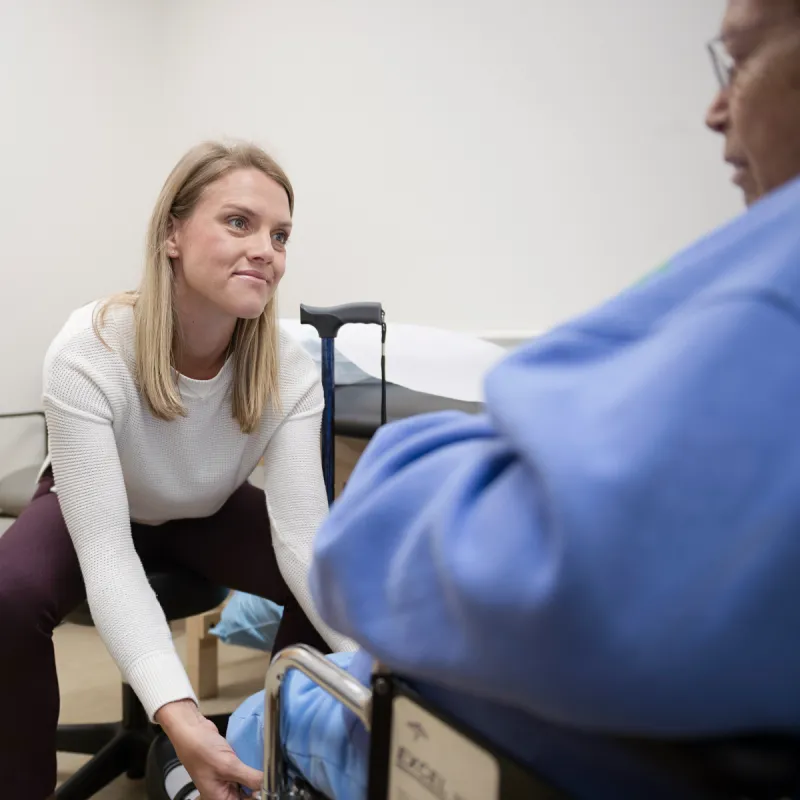
Why does my foot or ankle hurt?
Foot and ankle pain can come on suddenly after an injury or develop over time due to a chronic condition affecting your ligaments, bones or tendons. Common causes of foot and ankle discomfort are overuse, inflammation or an injury. Other health conditions contributing to foot pain include diabetes, gout and arthritis. Our foot and ankle specialists will pinpoint the source of your pain and work with you to develop a personalized treatment plan.
How do I soothe a foot or ankle injury?
If foot or ankle pain keeps you from participating in your favorite activities, there are steps you can take to alleviate it. Over-the-counter (OTC) pain relievers, ice and rest can ease minor discomfort from overuse or a mild sprain.
Consult with our therapists to create an exercise routine that strengthens and stretches the muscles and tendons in your feet and ankles. If the pain doesn't improve or it worsens, it may be time to see a foot and ankle orthopedic surgeon.
When do I need a foot and ankle doctor?
If you hear a loud snapping or popping sound, or you can't bend your foot downward, stand on your toes or you have pain and swelling, seek immediate treatment. You may have a severe sprain, an Achilles tendon injury or a bone fracture. Our urgent and emergency care teams can assess and X-ray the problem area and refer you to a nearby orthopedic foot doctor. Addressing the issue right away could avoid more significant problems down the road.
Foot and Ankle Pain Treatments

Many foot and ankle ailments don't require surgery. Our orthopedic foot and ankle specialists will work with you to find the best non-surgicl treatment option for you. There are lots of possible alternatives, such as physical therapy, acupuncture, arch supports and braces, custom orthotics, anti-inflammation medications and injection therapy.

If nonsurgical options aren't enough to correct your foot condition, our orthopedic team will recommend a minimally invasive procedure to bring you relief. This involves an orthopedic surgeon using a tiny camera and surgical tools to evaluate and repair damaged tissue, which may be caused by arthritis or a past injury. There are many benefits to minimally invasive surgery, such as less pain and swelling and the chance of infection.

If pain from arthritis, osteoarthritis or a previous foot injury persists, joint replacement (arthroplasty) may be the right solution for you. Discuss your treatment options with our orthopedic experts, like a robot-assisted procedure, to help you regain proper mobility.

If you've suffered a foot fracture or break, take the next step to healing. Get a thorough assessment and discuss your treatment options at one of our orthopedic walk-in care clinics and get on the road to recovery.

Over time, wear-and-tear or a sports-related foot or ankle injury can cause painful ligament or tendon damage. Our highly skilled foot surgeons can repair your torn ligaments and tendons or reconstruct them if they're beyond repair.
Why Choose Novant Health?
At the Novant Health Orthopedic & Sports Medicine Institute, we listen to your concerns and collaborate with you to create a personalized treatment plan.
You'll have access to an entire care team, including orthopedic surgeons, physical therapists, nutrition experts and mental health specialists. They'll walk you through each step of your journey, from diagnosis to treatment to rehabilitation.

As you're recovering from a foot or ankle condition, take advantage of the tools and resources we offer to get stronger and live a healthier life. We offer a range of wellness programs that will help you as you heal

Modern treatment techniques yield better results and faster recovery times. At Novant Health, we're dedicated to advancing healthcare through technological research. Our care experts make regular improvements to treatment to ensure you receive the safest, highest quality of care.
You'll have access to our advanced diagnostic and imaging tools, artificial intelligence for enhanced safety and quality, 3D modeling for custom implants and robotic-assisted surgical procedures.

We make every interaction a convenient and personalized experience, from finding educational resources online to scheduling an appointment. We'll work with you to determine the costs of your care and give you the tools to take charge of your healthcare.
Get access to invaluable tools including:
- Financial Navigator Service
- Mobile primary care units
- 24/7 on-demand virtual care
- Online MyChart access


What are the symptoms of an Achilles tendon injury?
An Achilles tendon injury stems from overuse or damage to your tendon. Several risk factors increase your chances of an Achilles tendon injury, such as bone spurs, wearing the wrong shoes or not properly stretching before exercising.
You may feel pain along the back of your leg near the heel or notice stiffness in the tendon when you wake. Other Achilles tendon injury symptoms include difficulty flexing your foot, discomfort or swelling and worsening foot or ankle pain during exercise.
Your orthopedic foot surgeon may recommend low-impact physical therapy and strength training, heel lifts or orthotic shoes, depending on the severity of the situation.
What are diabetic feet?
If you have diabetes, watch for signs of diabetic feet, also known as diabetic neuropathy. This occurs when high blood sugar damages the blood vessels and nerves in your feet, affecting blood flow. You may notice swelling, numbness or a loss of feeling in your feet.
Those with diabetic feet often don't realize they have a cut or blister. Poor blood flow means injuries to your foot and ankle take longer to heal, increasing the risk of infection. Early diagnostic and proper therapeutic approaches can get your condition under control.
